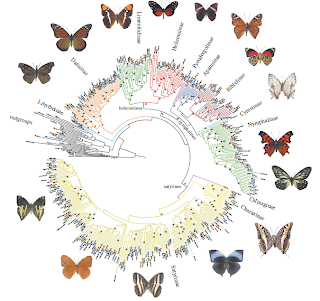文獻來源:Wahlberg, N., Leneveu, J., Kodandaramaiah, U., Pena, C., Nylin, S., Freitas, A. V. L. and Brower, A. V. Z. (2009) Nymphalid butterflies diversify following near demise at the cretaceous/tertiary boundary. Proc. R. Soc. B. doi: 10.1098/rspb.2009.1303
簡介
蛺蝶科分布廣泛,在生態系中為重要的植食性昆蟲,也同時是除了果蠅外的重要模式物種,在演化發育、擬態生物學等領域扮演重要角色。由於蛺蝶科為泛世界型分布的種類,其分化年代在本文章之前,僅有針對亞科級或是屬級進行定年,因此對於蛺蝶科的分化年代仍未有定論。本文章利用10個基因以及235型態特徵,重建蛺蝶科的親緣關係,包含400個分布於蛺蝶科主要支系的屬。作者們的分析顯示蛺蝶科的起源約為9000萬年前的白堊紀,而10-12個支系在新熱帶區與東方區的祖先則逃過了白堊紀末期的大絕滅災難。其分化的格局顯示其他支系的滅絕年代在白堊紀/第三紀的邊緣,以及在第三紀時種化效率較為快速。
Abstract
The butterfly family Nymphalidae contains some of the most important non-drosophilid insect model systems for evolutionary and ecological studies, yet the evolutionary history of the group has remained shrouded in mystery. We have inferred a robust phylogenetic hypothesis based on sequences of 10 genes and 235 morphological characters for exemplars of 400 of the 540 valid nymphalid genera representing all major lineages of the family. By dating the branching events, we infer that Nymphalidae originated in the Cretaceous at 90 Ma, but that the ancestors of 10–12 lineages survived the end-Cretaceous catastrophe in the Neotropical and Oriental regions. Patterns of diversification suggest extinction of lineages at the Cretaceous/Tertiary boundary (65 Ma) and subsequent elevated speciation rates in the Tertiary.


沒有留言:
張貼留言